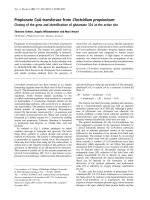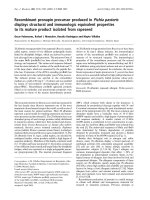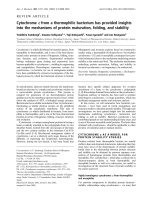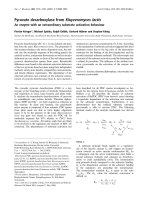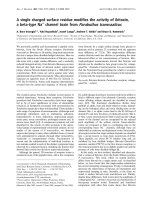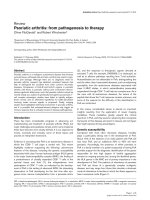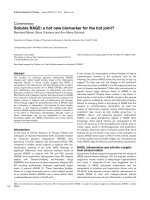Báo cáo Y học: Propionate CoA-transferase from Clostridium propionicum Cloning of the gene and identi®cation of glutamate 324 at the active site pdf
Bạn đang xem bản rút gọn của tài liệu. Xem và tải ngay bản đầy đủ của tài liệu tại đây (475.82 KB, 9 trang )
Propionate CoA-transferase from
Clostridium propionicum
Cloning of the gene and identi®cation of glutamate 324 at the active site
Thorsten Selmer, Angela Willanzheimer and Marc Hetzel
FB Biologie, Philipps-Universita
È
t, Marburg, Germany
Propionate CoA-transferase from Clostridium propionicum
has been puri®ed and the gene encoding the enzyme has been
cloned and sequenced. The enzyme was rapidly and irre-
versibly inactivated by sodium borohydride o r h ydroxyl-
amine in the presence of propionyl-CoA. The reduction of
the t hiol ester between a catalytic site glutamate and Co A
with borohydride and the cleavage by hydroxylamine were
used to introduce a site-speci®c label, which was followed
by MALDI-TOF-MS. This allowed the identi®cation of
glutamate 324 at the active site. Propionate CoA-transferase
and similar proteins deduced from the genomes of
Escherichia c oli, Staphylococcus aureus, Bacillus halodurans
and Aeropyrum pernix are proposed to form a novel subclass
of CoA-transferases. Secondary structure element predic-
tions were generated and compared to known crystal
structures in the d atabases. A h igh degree of structural
similarity w as obse rved between the arrange ment o f s ec-
ondary structure elements i n these proteins and glutaconate
CoA-transferase f rom Acid aminoc occus fermentans.
Keywords: Clostridium propionicum; alanine metabolism;
CoA-transferase; active site; thiol ester.
Clostridium propionicum has been isolated as an alanine
fermenting organism from the black mud of San Francisco
bay [ 1]. Th e fermentation products were acetate, ammonia,
carbon dioxide and propionate [2]. In contrast to other
organisms, which ferment alanine according to the
so-called randomising pathway with succinate a s a symmet-
ric intermediate, C. propionicum ferments alanine via the
nonrandomising pathway with acrylyl-CoA as c haracter-
istic intermediate. This pathway seems to be restricted to a
limited number of o rganisms, including Megasphaera
elsdenii [3], Bacteroides ruminic ola [4], C. propionicum and
Clostridium homopropionicum [5]. Serine and cysteine are
fermentedinasimilarmannerbyC. propionicum yielding
acetate and propionate. Likewise, threonine is fermented
to propionate and butyrate as volatile fatty acid end
products.
As outline d in Fig. 1, alanine undergoes an initial
oxidative cleavage to a mmonia and pyruvate, the latt er
being either oxidized to carbon dioxide and acetate o r
reduced to (R)-lactate. (R)-Lactate is subsequently reduced
to propionate by reactions carried out at the c oenzyme A
thiol ester level rather than using the free carboxylates. A
critical step in the reductive branch of this pathway is the
activation of (R)-lactate as its (R)-lactoyl-CoA derivative.
This reaction is carried out by the enzyme propionate:ace-
tyl-CoA CoA-transferase (EC 2 .8.3.1, also known as pro-
pionate CoA-transferase), which has b een demonstrated to
activate (R)-lactate using the end product of the reduction,
propionyl-CoA, or acetyl-Co A as a c oenzyme A donor [6]
(Eqn 1).
RÀlactate propionyl À CoA
propionate RÀlactoyl À CoA 1
The enzyme has been p reviously puri®ed and character-
ized as a homotetrameric enzyme (a
4
) with an apparent
molecular subunit m ass o f 6 7 kDa [6]. Although a prefer-
ence of (R)- lactate over (S)-lactate was observed, the
enzyme exhibited a rather broad substrate speci®city for
monocarboxylic acids including acrylate, propionate and
butyrate whereas dicarboxylic acids were not used.
The g eneral mechanism for the C oA-transferases has
been suggested to proceed via the successive formation o f
a m ixed anhydride between the C oA-donor carboxylic
acid an d an essential glutamate residue of the enzyme,
followed by t he formation of an e nzyme-CoA thiol ester
intermediate. The product is then f ormed by a n inverted
sequence of these steps with the acceptor carboxylate [7].
More recently, a number of CoA-transferases have been
discovered, which apparently do not follow this general
mechanism [8,9]. Formation of an enzyme-CoA thiol ester
can be detected either by site-speci®c cleavage of the
polypeptide chain [10], reduction of the t hiol ester w ith
sodium borohydride [11±13] or directly by mass spect-
rometry [14]. Alternatively the mixed anhydride interme-
diates can be detected by the formation of stable
derivatives of the catalytic glutamate and hydroxamic
acids [15] or indirectly by oxygen exchange experiments
[14,16].
To date, only the crystal structure of glutaconate CoA-
transferase (EC 2.8.3.12) from Acidaminococcus fermentans
has been solved. In contrast to the homotetrameric propi-
onate CoA-transferase of C. propionicum,theformer
enzyme is a hetero-octameric protein (a
4
b
4
), whose structure
belongs t o t he open a he lix/b sheet protein family and has
Correspondence to T. Selmer, FB Biologie, Philipps-Universita
È
t,
D-35032 Marburg, Germany. Fax: + 4 9 6421 2828979,
Tel.: + 49 6421 2825606, E-mail:
Enzymes: propionate CoA-transferase (EC 2.8.3.1); glutaconate
CoA-transferase (EC 2.8.3.12).
(Received 3 August 2 001, revised 5 November 2001, accepted 7
November 2001)
Eur. J. Biochem. 269, 372±380 (2002) Ó FEBS 2002
been described as four-layered a helix/a helix/b she et/a
helix type with a novel topology [17]. T his topology is
found in both subunits and differs considerably from other
a helix/b sheet proteins including nucleotide-binding
domains.
In this communication, we report the cloning and
sequencing of the gene encoding propionate CoA-transfer-
ase from C. prop ionicum and present experimental evidence
that glutamate 324 acts as the catalytic carboxylate.
MATERIALS AND METHODS
Materials
Sequencing grade proteases were pur chased from Boehrin-
ger Mannheim (Germany). Coenzyme A (trilithium salt)
was from ICN Biomedicals (Eschwege, Germany). All other
chemicals were of the highest grade available and from
common commercial sources. C. propionicum (DSMZ
1682) was purchased from the German collection of
microorganisms and cell cultures (DSMZ, Braunsc hweig,
Germany).
Synthesis of acyl-CoA substrates
Acetyl-, butyryl- and propionyl-CoA were prepared from
the corresponding anhyd rides and CoA by the method of
Simon & Shemin [18]. All CoA-derivatives were puri®ed as
described previously [14].
Enzyme assay
The enzyme test for propionate CoA-transferase activity
was carried out at 25 °C as described previously [19].
Cultivation and storage of microorganisms
C. pr opionicum was cultivated in a complex medium
containing
D
,
L
-alanine as the s ole s ource of energy, as
described previously [6]. Freshly prepared anaerobic media
were inoculated with 5 to 20% stationary or late exponential
precultures and grown for 24 to 36 h at 37 °C. The cells
were harvested by centrifugation and stored at )80 °C.
Preparation of cell free extracts of
C. propionicum
Frozen cells (20 g) were suspended i n 100 mL of 25 m
M
potassium ph osphate, 1 m
M
dithiothreitol, 1 m
M
EDTA,
1m
M
MgCl
2
, pH 7.0 (Buffer A). The suspension was
homogenized by sonication on ice for 15 min. Poly(eth yl-
eneimine) (0.2% m/v ®nal concentration) was added and the
crude extract w as centrifuged for 45 min at 100 000 g.The
clear supernatant was stored on ice until used.
Puri®cation of propionate CoA-transferase
All puri®cation steps were carried out at 4 °C. The
clear extract was applied to a Q-Sepharoseä column
(2.6 ´ 10 cm, Pharmacia) equilibrated with buffer A. The
column was w ashed with 50 mL o f buffer A and developed
bya500-mLlineargradientof0to500m
M
NaCl in b uffer
A. Fractions containing CoA-transferase activity w ere
pooled and adjusted t o a ®nal concentration o f 1
M
(NH
4
)
2
SO
4
11
. The solution was centrifuged for 45 m in at
100 000 g and app lied i n four aliquots to a Resource-Pheä
column (1 mL vol., Pharmacia) equilibrated with 1
M
(NH
4
)
2
SO
4
in buffer A. The column was washed with
5 m L of the starting buffer and the proteins were eluted in a
50-mL linear gradient from 1 to 0
M
(NH
4
)
2
SO
4
.The
pooled enzyme was dialysed overnight against 5 m
M
of each
boric, citric and phosphoric acids and 5 m
M
Tris adjusted to
pH 7.0 with KOH (buffer B) and then applied on a
Resource-Qä column (1 mL vol., Pharmacia) equilibrated
with buffer B. T he protein w as eluted by a linear gradient
(50 m L) from 0% to 100% of buffer B adjusted to pH 2.0
with HCl. The collected fractions at pH 5.0±5.1 were
immediately neutralized by the addition of potassium
phosphate, pH 7.5. When required, the protein solution
was adjusted t o a ®nal concentration of 200 m
M
sodium
acetate and subjected to gel ®ltration o n S ephadex G 25,
equilibrated with buffer A, t o obtain CoA-free protein. T he
puri®ed enzyme was ®lter-sterilized and stored a t 4 °Cfor
several months without signi®cant loss in activity. The
purity of the enzyme was con®rmed by SDS/PAGE with
Coomassie-staining of the proteins and by RP-HPLC
followed by mass spectrometry [14].
Fig. 1. The fermentation o f alanine by Clostridium propionicum. Th e
amino acid alanine is fermented according to Eqn (1)
alanine + 2 H
2
0 ® 3NH
4
+
+CO
2
+ aceta te
±
+ 2 propionat e
±
,
DG° )135 kJ ámol
)1
acetate. The enzymes in volved are p yru-
vate:glutamate transaminase ( 1), g lutamate dehydrogenase (2)
(R)-lactate dehydrogenase (3), propionate C oA-transferase (4)
(R)lactoyl-CoA dehydratase (5), acrylyl-CoA reduc tase complex (6),
pyruvate:formate lyase (7), pho sphotransacetylase (8), acetate kinase
(9) and formate dehydrogenase (10). 2OG, 2-oxoglutarate. Ac-CoA,
acetyl-CoA. Ac-P
i
, acetylphosphate.
Ó FEBS 2002 Propionate CoA-transferase (Eur. J. Biochem. 269) 373
N-Terminal sequencing
Puri®ed e nzyme (20 lg) was subjected to SDS/PAGE and
blotted onto a poly(vinylidene di¯uoride) m embrane. A fter
staining of the membrane w ith Coomassie blue R 450, the
protein band was cut out and subjected t o N -terminal
sequencing by gas-phase Edman degradation.
Generation and puri®cation of internal peptides
The p uri®ed enzyme (20 0 lg) was freeze-dried, reductively
carboxymethylated and digested with trypsin as described
previously [14]. T he peptides were puri®ed by RP-HPLC
using a Supelco sil-LC318 column (4.6 ´ 250 mm, 5 lm,
300 A
Ê
) equilibrated with 0.1% ( v/v) tri¯uoroacetic acid and
eluted with a line ar gradient of 0±42% (v/v) acetonitrile
within 42 min. The elution of the peptides was monitored
simultaneously at 210 and 280 nm. Peptides exhibiting an
absorbance at 280 nm were re-applied to the same column
using an identical gradient in the presence of 0.1% (v/v)
hexa¯uoroacetone-ammonia, pH 6.0, and analysed by
MALDI-TOF-MS as described previously [14]. Two pep-
tides of suitable size and purity were subjected to N-terminal
sequencing.
Cloning and DNA-sequencing
A degenerated primer pair was deduced from the
N-terminus of the enzyme a nd from an in ternal peptide
(Table 2) and used to amplify a % 300-bp PCR p roduct
from genomic DNA of C. propionicum. T he PCR p roduct
was cloned and sequenced using the TOPO TA-cloning kit
according to the manufacturer's instructions.
The PCR-product w as labelled with digoxygenin a nd
used to screen EcoR1 fragments of genomic DNA from
C. propionicum cloned in a k-ZAP-Express phage. Two
positive clones were isolated, plasmids were excised from the
vector and the inserts were sequenced using standard
laboratory protocols. The sequence data w ere analysed
using the
EXPASY
(Expert Protein Analysis System) server of
the Swiss Institute of Bioinformatics, the c omputational
molecular biology facilities provided by the National
Institute of H ealth and the 3
D
-
PSSM
Web Server V 2.0
provided by the I mperial Cancer Research Fold Re cogni-
tion Server [20,21].
Site-speci®c label of the catalytic glutamate residue
Propionate CoA-transferase (50 lg) was incubated for
2 m in at 25 °Cin50m
M
potassium phosphate, pH 7.0,
either in the presence o r absence of 100 l
M
propionyl-
CoA. Either hydroxylamine hydrochloride (pH 7.5,
200 m
M
®nal concentration) or sodium borohydride
(20 m
M
®nal concentration) were added and the reaction
was a llowed t o proceed for another 10 min at 25 °C.
Aliquots of t he samples were assayed for CoA-transferase
activity. The samples were reductively carboxymethylated
andthebufferwasexchangedbygel®ltrationtoyield
50 m
M
ammonium acetate, pH 8.0, 10% (v/v) acetonitrile.
Each sample was s plit into four equal volumes and
digested for 16 h at 37 °C i n the presence of either 2%
(w/w) chymotrypsin, endoproteinase AspN, endoprotein-
ase GluC ( V8 protease) or 2% ( w/w) trypsin. The samples
were acidi®ed with 0.01 vo l. of 2
M
tri¯uoroacetic acid and
analysed by MALDI-TOF-MS.
RESULTS
Puri®cation of propionate CoA-transferase
The propionate CoA-transferase was puri®ed from C. pro-
pionicum grown on a lanine as the sole s ource of energy and
carbon. Ion exchange chromatography on Q-Sepharose
completely separated t he propionate CoA-transferase (elu-
tion at 270±285 m
M
NaCl) from phosphotrans-acetylase
(elution at 130±150 m
M
NaCl), which contributed to 50%
of the apparent transferase activity in cell-free extracts.
Most of the contaminating proteins w ere removed by
hydrophobic interaction chromatography on a Resource-
Phe column [elution at 700 m
M
(NH
4
)
2
SO
4
]. The remaining
impurities were removed b y ion exchange chromatography
on Resource-Q u sing a d ecreasing pH-gradient (elution at
pH 5.1±5.0).
As demonstrated in Fig. 2 and Table 1, t he enzyme was
essentially pure after these puri®cation steps. The enzyme
was 37-fold enriched to a speci®c activity of 85 U ámg pro-
tein
)1
. In addition to the predominating polypeptide with an
apparent molecular mass of 60 kDa in SDS/PAGE, t wo
faint bands were observed around 40 and 20 kDa. These
additional bands were completely absent when the puri®ed
enzyme was incubated in t he presence of sodium acetate
followed by gel ®ltration on Sephadex G25, but accounted
for up to 30% of the total protein when the enzyme was
incubated with 100 l
M
propionyl-CoA, prior to sample
preparation. These data indicated that a small but signi-
®cant fraction of the puri®ed CoA-transferase w as trapped
as the enzyme-CoA thiol ester intermediate. It has been
Fig. 2. The p uri®cation of propionate CoA-tran sferase. ACoomassie
blue staine d 10% SDS/PAGE is shown. The arrows indicate the
position of two faint bands at 40 kDa and 20 kDa in lanes 2±4 which
are absent in lane 5. Cell free extract (lane 1, 50 lg), Q-Sepharose (lane
2, 10 lg), Resource-Phe (lane 3, 5 lg) , Resource-Q (lane 4, 5 lg). The
protein in lane 5 is ide ntical to lane 4 , but has been i ncub ated with
200 m
M
sodium acetate prior sample preparation.
374 T. Selmer et al. (Eur. J. Biochem. 269) Ó FEBS 2002
previously shown that glutamate thiol ester-containing
proteins, such as CoA-transferases and a2-macroglobulin,
are site-speci®cally cleaved at elevated temperature [22]; a
nucleophilic attack of the p eptidyl amide nitrogen of the
glutamyl residue to the thiol ester carbonyl, releases the thiol
forming a protein-bound 4-oxoproline residue. The peptide
bond between this residue and the preceding amino acid is
easily hydrolysed to yield a truncated pr otein and a
C-terminal polypeptide, which is N-terminally blocked b y a
pyroglutamyl residue [23]. To our knowledge, the propio-
nate CoA-transferase is the ®rst CoA-transferase that has
been partially puri®ed in this catalytic intermediate form.
The protein exhibited rather broad signals for the single
and double protonated m olecular ions in MALDI-TOF-
MS measurements, indicating a molecular mass of
56 607 6 0 D a. The molecular mass of the transferase
increased by 750 Da when the enzyme was incubated i n the
presence of 100 l
M
propionyl-CoA prior to the measure-
ments, indicating the f ormation of an enzyme CoA-thiol
ester as a covalent catalytic intermediate.
Cloning and sequencing of the gene encoding
propionate CoA-transferase
The enzyme w as blotted onto a poly(vinylidene di¯uoride)
membrane and subjected to Edman degradation. Internal
peptides were generated by cleavage with trypsin and
puri®ed to homogeneity by RP-HPLC. Two of these
peptides were sequenced by Edman degradation. A degen-
erated primer pair was d educed from the N-terminus and
from one of these peptides (Table 2), which was used to
amplify a 3 00-bp fragment o f genomic DNA from C. pr o-
pionicum by PCR. The fragment was cloned into a TOPO
TA vector and sequenced. The sequence w as in accordance
with the amino-acid sequences used for primer deduction
and was similar to other CoA-transferases in the databases.
A labelled PCR-product was used to screen a library of
genomic DNA from C. propionicum in a k-ZAP-Express
vector. Two clones were isolated and excised from the phage
to yield the corresponding plasmid, which was subsequently
sequenced. The clones contained identical inserts of 2.7-kb
and e ncoded t he complete 524 amino-acid ORF corre-
sponding to the propionate CoA-transferase (Fig. 4).
According to the amino-acid sequence, an average molec-
ular mass of 56 553 Da and a n isoelectric point of 4.9 1 was
predicted for the encoded p rotein. B oth values w ere in
agreement with the observed molecular mass and the elution
of the enzyme during the ®nal puri®cation step.
In addition to the CoA-transferase gene, a second ORF
(lcdB), encoding 122 C-terminal amino acids of a protein
similar to the 2-hydroxyglutaryl-CoA dehydratase b subunit
of A. fermentans, was detected upstream of the transferase
gene. This gene probably encodes one subunit of the (R)-
lactoyl-CoA d ehydratase required in the reductive pathway
from alanine to propionate. Directly downstream of the
propionate CoA-transferase gene (pct), an AT-rich region
was found that resembles rho-independent termination
signals. The nucleotide sequence of the full insert has b een
deposited under t he accession number AJ276553 in the
EMBL nucleotide sequence database.
Sequence analysis
The amino-acid sequence of propionate CoA-transferase
was compared to o ther proteins in the database using the
BLAST
algorithm [24,25]. The protein was most similar t o a
putative acetoacetate:acetyl-CoA CoA-transferase from
B. ha lodu rans (B84137, 56% identity, 519 amino-acid
overlap [26]), and hypothetical proteins f rom E. coli
(E85777 ydiF, 45% i dentity, 519 amino-acid overlap [ 27]),
Aeropyrum pernix (D72478, 38% ident ity, 541 amino-acid
overlap [28]), and Staphylococcus aureus (F89786, 36%
identity, 519 amino-acid overlap [29]). Other hits were
CoA-transferases from various microorganisms including
Table 1. Puri®cation of pro pionate CoA-transferase from C. propionicum. The enzyme Activity was measured as described e arlier [6]. O ne unit of
propionate CoA-transferase act ivity corresponds to the f ormation of 1 lmol a cetyl-CoA p er min from propionyl-CoA (100 l
M
) a nd ace tate
(200 m
M
)at25°C. No te that the activity in the cell free extract is the sum of CoA-transferase and phosphotransacetylase and that the l atter enzyme
is completely s eparated from the CoA-transferase by t he ®rst colu mn.
Puri®cation step
Total activity
(U)
Protein
(mg)
Speci®c activity
(Uámg
)1
)
Puri®cation factor
(fold)
Yield
(%)
Cell free extract 3200 1391 2.3 1 100
Q-Sepharose 1560 46 34 15 49
Resource-Phe 1428 20 70 30 45
Resource-Q 1306 15 85 37 41
Table 2. N-terminal sequencing and PCR-primer deduction. The N-terminal amino acid sequences of the puri®ed, blotted protein and of two internal
peptides are shown. These sequ ences have been used to deduce a degenerated prime r pair for ampli®cation of a propionate CoA-transferase speci®c
probe f rom C. propionicum genomic DNA. M AorC,N A, G, C or T, R AorG,H A, C o r T, Y CorT.
Region/peptide Amino-acid sequence Deduced PCR primer
N-Terminus MRKVPIITADEAAKLIK-D Sense: 5¢-ATGMGNAARGTNCCNATHATHACN
GCNGAYGCTGC-3¢
Peptide 1 YIAGHWATVPALGK Antisense: 5¢)CCNARNGCNGGNCANATNGCC-3¢
Peptide 2 GTYADESGNITFEKEVAPLEGTSV-QA Not used
Ó FEBS 2002 Propionate CoA-transferase (Eur. J. Biochem. 269) 375
Deinococcus radiodurans, B acillus s ubtilis, Streptomyces
coelicolor, Heliobacter pylori, Mycobacterium tuberculo-
sis, Haemophilus in¯uenzae and Clostridium acetobutylicum.
These latter e nzymes belong to the 3 -oxoadipate CoA-
transferase protein superfam ily and consist of t wo diff erent
subunits. The similarity of these latter sequences to propi-
onate CoA-tansferase was lower (23±28%) and restricted to
the larger subunit of these enzymes (232±255 amino-acids
overlap). However, when the C-terminal half of the amino-
acid sequence of propionate-CoA-transferase was used for
database search, t his part o f the sequ ence showed similarity
to the smaller subunits of the latter enzymes.
The catalytic glutamate residue of hetero-oligomeric
enzymes b elonging to the 3-oxoadipate CoA-transferase
superfamily is found in the small subun it and is located
within a so-called (S)ENG motif [11]. This characteristic
motif is not found in the sequence of propionate CoA-
transferase or i n any of the putative proteins from
B. halodurans, E. coli, A. pe rnix or S. aureus.Therefore,a
multiple sequence alignment o f the b subunits of 3-oxoadi-
pate CoA-transferase a nd the C -terminal h alf (starting with
Leu276) of propionate CoA-transferase from C. propioni-
cum was generated using
CLUSTALW
. The most likely
candidate for the catalytic glutamate of propionate CoA-
transferase based on these data was glutamate 324 (Fig. 3 ).
Detection of glutamate 324 as the catalytic
carboxylate of propionate CoA-transferase
As the sequence analysis d id not allow an unequivocal
identi®cation of the catalytic glutamate of propionate CoA-
transferase, this residue was s peci®cally labelled. The thiol
ester in the proposed enzyme-CoA intermediate of the CoA-
transferase reaction cycle is more reactive than, for example,
free propionyl-CoA. This higher reactivity allows the
reduction of the thiol ester with sodium borohydride to
yield a protein-bound 2-amino-5-hydroxyvaleryl r esidue
[11]. In addition, it has been shown that nucleophiles such as
methylamine or hydroxylamine can cleave enzyme-bound
thiol esters [22], yielding N-methylglutamine or the corre-
sponding hyd roxamic acid. T hese reactions are useful tools
for identifying the c atalytic residue, a s the derivat ives give
rise to changes in the molecular m asses o f peptides that
originate from the protein inactivated by either borohydride
()14 Da) or hydroxylamine (+15 Da).
When propionate CoA-transferase was incubated with
100 l
M
propionyl-CoA in the presence of either sodium
borohydride ( 20 m
M
) o r hydroxylamine (pH 7.5, 2 00 m
M
),
the en zyme w as rapidly and irreversibly inactivated. The
inactivation was strictly dependent on the presence of
propionyl-CoA.
The inactivated proteins and controls, which had been
incubated with the reagents but without propionyl-CoA,
were subjected to reductive carboxymethylation and desalt-
ed by gel ®ltration. Aliquots of t hese samples were digested
for 16 h at 37 °C with 2% (w/w) of either chymotrypsin,
endoprotease-AspN, en doprotease-GluC o r trypsin. The
peptides were analysed by MALDI-TOF-MS without
puri®cation. Altho ugh only around 30±50% of the predict-
ed peptides were detected in one particular digest, all four
samples together c overed the full amino-acid sequence
predicted by the gene.
The molecular masses of peptides carrying the proposed
catalytic glutamate 324 were found in all s amples except t he
endoprotease-GluC digest. The masses of these peptides
exclusively s howed differences for inactivate d samples and
controls. As summarized in T able 3, the derivatives showed
the predicted mass differences of )14 Da and +15 Da for
sodium borohydri de and hydroxylamine inactivated
enzyme, r espectively. In particular the observation of a
chymotryptic peptide comprising amino acids 322±338 was
very crucial, since this peptide contains the glutamate 324 as
the sole c arboxylate. Therefore, the tentative assignment of
glutamate 324 has been con®rmed by these experiments.
DISCUSSION
Propionate CoA-transferase from C. propionicum has been
puri®ed and initially characterized previously [6]. In this
communication we report an i mproved puri®cation proto-
col for the enzyme. The gene encoding the protein was
cloned, sequenced and g lutamate 324 was identi®ed as the
active site glutamate residue.
The gene encoding propionate CoA-transferase from
C. propionicum was cloned and sequenced. The encoded
protein was similar to CoA-transferases belonging to the
Fig. 3. Sequence alignment of t he active site region of various h eterooligomeric CoA-transferases and propionate CoA-transferase. The amino acid
sequences surrounding the characteristic (S)ENG-motif of the former proteins is shown. Note that this motif is not easily recognized in propionate
CoA-transferase from C. propionicum (Cpro). The consensus sequence shows amino acids which are conserved in at least eight out of 12 enzymes.
Pput, Pseudomo nas putida; Acal, Acinetobacter calcoaceticus; Drad, Deinococcus radiodurans; Bsub, Bacillus subtilis; Scoe, Streptomyces coelicolor;
Hpyl, Heliobacter pylori; Mtub, Mycobacterium tuberculosis; Hinf, Haemophilus in¯uenzae; Cace, Clostridium acetobutulicum.
376 T. Selmer et al. (Eur. J. Biochem. 269) Ó FEBS 2002
3-oxoadipate CoA-transferase s uperfamily. However,
whereas these proteins consist of two subunits and contain
a highly indicative ®ngerprint motif [(S)ENG] surrounding
the a ctive centr e glutamate, p ropionate CoA- transferase
consists of one polypep tide and the ®ngerprint m otif is not
found in this protein. A site-speci®c label of the catalytic
glutamate via the thiol ester catalytic intermediate , either by
reductive cleavage with borohydride or by cleavage with
hydroxylamine allowed the identi®cation o f the active site
carboxylate. The predicted derivatives were located exclu-
sively on glutamate 324, which led us to conclude that this
residue is the active site carboxylate.
The proteins most similar to propionate CoA-transfer-
ase in the databases are a putative acetoacetate CoA-
transferase from Bacillus halodurans and o ther proteins
with as yet u nknown function from Escherichia coli,
Aeropyrum pernix and Staphylococcus aureus. O ur data
strongly suggest that these genes encode CoA-transferases.
As shown in F ig. 4 , the proteins align well, and in
particular the glutamate residue 324 is c onserved a mong
all these proteins. It seems therefore reasonable to
conclude that these proteins form a novel subclass of
CoA-transferases. These en zymes lack t he characteristic
(S)ENG consensus motif of members of th e 3-oxoadipate
CoA-transferase superfamily and e xhibit either a homool-
igomeric or monomeric quarternary structure. It is
reasonable to s uggest that a gene fusion could h ave
occurred during the evolution of the former enzymes.
Such a natural g ene fusion has also been suggested for the
mammalian oxoadipate CoA-transferase [30]. In agree-
ment with this proposal, i t has been shown t hat the two
subunits of glutaconate CoA-transferase from A. fermen-
tans could b e f used with genetic tools to y ield an active
enzyme composed of a single polypeptide [31].
Fig. 4. Sequence alignment of propionate
CoA-transferase and similar p roteins derived
from genome projects. The p ropionate CoA-
transferase from Clostridium propionicum
(Cpro) is compared to proteins encoded in the
genomes o f Bacillus h alodurans (Bhal),
Eschrichia coli (Ecol) and Aeropyrum pernix
(Aper). The sequ ence s have b een align ed using
CLUSTALW
. Residues i dentical in at least three
proteins are s haded. Invariant p ositions are
marked with asterisks a nd conservative
exchanges a re marked by dots. The catalytic
glutamate is s hown in bold and a mino acid
con®rmed b y amino a cid sequencing for
propionate CoA-transferase are underlined.
Ó FEBS 2002 Propionate CoA-transferase (Eur. J. Biochem. 269) 377
Despite the low sequence similarities of different CoA-
transferases on the amino acid sequence level, CoA-
transferases have been predicted to h ave a very similar f old
[17]. In agreement with this proposal, we found that the
secondary structural elements predicted f or the amino-acid
sequence of propionate CoA-transferase superimpose very
well with the known elements in the crystal structure of
glutaconate CoA-transferase ( Fig. 5). Nevertheless, there
are some s triking differences in the arrangement of t he
secondary structural elements, which can partially be
explained by the known biochemical properties of the
enzymes. As shown in Fig. 5 A,B, the secondary structure
elements in glutaconate CoA-transferase form two ou ter
layers of a helices followed by one layer of b sheets a nd an
inner l ayer of ahelices. This arrangement is found in bo th
subunits of the protein. I t is r emarkable that the outer layer
of a helices in the large subunit of glutaconate CoA-
transferase (Fig. 5A) is apparently missing in pr opionate
CoA-transferase ( Fig. 5C). The crystal str ucture has shown
that two antiparallel b sheets (Fig. 5B, triangles 6 and 7,
respectively) of the b subunit of g lutaconate CoA-tr ansfer-
ase p rotrude into a cleft on the s urface of the a subunit a nd
are involved in mediation of subunit interactions. Therefore,
the lack of this e lement (Fig. 5C) is not surprising when the
homooligomeric structure o f propionate CoA-transferase is
taken i nto a ccount. A n a dditional i nteresting difference
between both structures i s the lack of a subdomain formed
by two b sheets and one a helix connecting the bsheet 2 of
the b subunit, which carries the catalytic glutamate, with the
inner l ayer of a helices (Fig. 5B, triangles 3 and 4 and circle
3, respectively). This subdomain is thought to be involved in
the substrate binding of glutaconate CoA-transferase. It has
been suggested that two speci®c serine residues, Ser78 (in
subunit A) and Ser68 (in subunit B ), are involved i n the
formation of hydrogen bonds with the e-carboxylate of
glutaryl-CoA and t hat the latter s erine is located within this
subdomain. It is remarkable that both residues are appar-
ently replaced by stretches of rather hydrophobic residues in
propionate CoA-transferase and it is reasonable to conclude
that the additional subdomain in glutaconate CoA-trans-
Table 3. Mass spectrometry of peptides derived from controls and i nactivated p ropionate CoA -transferase. Propionate CoA-transferase w as i ncu-
bated in the absence (control) or presence of propionyl-CoA with either hydroxylamine (200 m
M
) or sodium borohydride (20 m
M
) as described in
Material and methods. The prote in was reductivel y carboxymethylated and subsequently digested with the proteases as indicated. The p eptides
were analysed by MALDI-TOF-MS as described elsewhere [14]. The molecular masses expected for the controls (E
324
COOH), hydroxyl-
amine- (E
324
CONHOH) or borohydride-treated (E
324
CH
2
OH) peptides is given in parentheses. The catalytic glutamate residue is shown
in bold. Unless stated otherwise, the measured and calculated molecular masses are given as monoisotopic masses. For trypsin, both calculated and
measured va lues refer t o the average mass.
Digest Sequence Control
Hydroxylamine
(+15 Da)
Borohydride
()14 Da)
Chymotrypsin
322
TAESGAIGGVPAGGVRF
338
1547 (1547) Da 1563 (1562) Da 1533 (1533) Da
Endoproteinase-AspN
317
DFMTLTAESGAIGGVPAGGVRFGASYNA
344
2718 (2717) Da 2733 (2732) Da 2705 (2703) Da
Trypsin
286
GAIELEKDVAVNLGVGAPEYVASVADEEG
IVDFMTLTAESGAIGGVPAGGVR
337
5107 (5105) Da 5122 (5120) Da 5094 (5091) Da
Fig. 5. Structural similarity of glutaconate CoA-transferase (A,B) [15] and the predicted topology of secondary structure elements in propionate CoA-
transferase (C). The topological diagram shows the arrangement of secondary structure elements. These structure elements have been predicted for
propionate CoA-transferase by the program 3
D
-
PSSM
provided by the Imperial Cancer Research Fold Recognition Server. These elements have
been aligned to the structure of glutaconate CoA-transferase. Elements homologous to the a subunit of glutaconate CoA-transferase are given in
black, those h omologous to the b subunit in white. T he a helices are shown by circles a nd the bsh eets by triangles. The position of t he catalytic
glutamates is marked by a dot.
378 T. Selmer et al. (Eur. J. Biochem. 269) Ó FEBS 2002
ferase represents an adaptation for t he binding o f a
dicarboxyl-CoA by the latter enzyme.
During the course of our research, an interesting obser-
vation was made. A ll attempts to exp ress the cloned gene
from C. propionicum in E. coli failed (A. Willanzheimer,
unpublished observations)
22
; the transformed E. coli cells
carrying an isopropyl thio-b-
D
-galactoside-inducible expres-
sion vector exhibited no g rowth defect until the p rotein was
induced by isopropyl thio-b-
D
-galactoside. Upon induction
of the protein, E. coli stopped growing. T hese observations
may point to a severe impairment of the cellular metabolism
of E. coli by the C. prop ionicum enzyme. Although the
reason for this impairment of growth for the h ost has not
been elucidated as yet, a likely explanation could be t he
formation of lactoyl-CoA and other short-chain fatty acid
CoA-thiolesters by the enzyme. Such reactions are predicted
to signi®cantly lower t he intracellular acetyl-CoA pool.
Therefore, growth inhibition by the formation of products,
which i nterfere with essential metabolic pathways [32], may
occur. However, further experiments will be required to
establish the reason for the observed growth defects.
ACKNOWLEDGEMENTS
We are very grateful to W. Buckel for his constant support throughout
this project. K. Neifer and B. Schmidt from the Zentrum fu
È
r
Molekulare Biologie und Biochemie of t he George-August University,
Go
È
ttingen, we thank for protein sequencing. This work was supported
by grants from the Deutsche Forschungsgemeinschaft and the Fonds
der Chemischen Industrie.
REFERENCES
1. Cardon, B .P. & Barker, H.A. (1946) Two new amino-acid-
fermenting bacteria, Clostridium propionicum and Diplococcus
glycinophilus. J. Bacteriol. 52 , 629±634.
2. Cardon, B.P. & Barker, H.A. (1947) Amino acid fermentations by
Clostridium propionicum and Diplococcus glycinophilus. Arch.
Biochem. Biophys. 12, 165±171.
3. Elsden, S.R., Volcani, B.E., Gilchrist, F.M.C. & Lewis, D. (1956)
Properties of fatty acid forming organism isolated from the rumen
of sheep. J. Bacteriol. 72, 681±689.
4. Wallnoefer, P., B aldwin, R.L. & Stagno, E. (1966) Conversion of
14
C-labeled substrates to volatile fatty acids by the rumen micro-
biota. Appl. Microbiol. 14 , 1004±1010.
5. Dorner, C. & Schink, B. (1990) Clostridium homopropionicum sp.
nov., a new strict anaerobe growing with 2-, 3-, or 4-hydrox y-
butyrate. Arch. Microbiol. 154, 3 42±348.
6. Schweiger, G . & B uckel, W. (1984) On the dehydration of (R)-
lactate in the fermentation of alanine to propionate by Clostridium
propionicum. FEBS Lett. 171, 79±84.
7. White, H. & J encks, W.P. (1 976) Mechanism a nd speci®city of
succinyl-CoA: 3-ketoacid coenzyme A transfe rase. J. Biol. Chem.
251, 1688±1699.
8. Leutwein, C. & Heider, J . ( 2001) Succinyl-CoA: (R.) -benzylsuc-
cinate CoA-transferase: an enzyme of the anaerobic to luen e
catabolic pathway in denitrifying bacteria. J. Bacteriol. 183, 4288±
4295.
9. Dickert, S., Pierik, A.J., Linder, D. & Buckel, W. (2000) The
involvement of coenzyme A esters in the dehydration of
(R)-phenyllactate to (E)-cinnamate by Clostridium sporogenes.
Eur. J. Biochem. 267, 3 874±3884.
10. Rochet, J.C. & Bridger, W.A. (1994) Identi®cation o f glutamate
344 as the c atalytic residue i n t he ac tive site of pig heart CoA
transferase. Pro tein Sci. 3, 975±981.
11. Mack, M., B endrat, K ., Zelder , O., Eckel, E., Linder, D. &
Buckel, W. (1994) Location of the two genes encoding glutaconate
coenzyme A-transferase at the beginn ing of t he hydroxyglutarate
operon in Acidaminococcus fermentans. Eur. J. Bioc hem. 226,
41±51.
12. Moore, S.A. & Jencks, W.P. (1982) Formation of active site thiol
esters of CoA t ransferase and the dependence of catalysis o n
speci®c binding inter actions. J. Biol. Chem. 257, 10893±10907.
13. Tung, K.K. & Wood, W .A. (1975) Puri®cation, ne w assay, and
properties of coenzyme A transferase fro m Peptostreptococcus
elsdenii. J. Bacteriol. 124, 1462±1474.
14. Selmer, T. & Buckel, W. (1999) Oxygen exchange between acetate
and the catalytic g lutamate residu e in g lutaconate CoA-transferase
from Acidaminococcus fermentans. Implica tions fo r the m ec h-
anism of CoA-ester hydrolysis. J. Bio l. Chem. 274, 20772±20778.
15. Pickart, C.M. & Jencks, W.P. ( 1979) Form ation of s table a nhy-
drides from CoA transferase and hydroxamic acids. J. Biol. Chem.
254, 9120±9129.
16. Benson, R.W. & B oyer, P.D. (1969) The participation of a n
enzyme-bound oxygen group in a coenzyme A transferase
reaction. J. Bio l. Chem. 244, 2366±2371.
17.Jacob,U.,Mack,M.,Clausen,T.,Huber,R.,Buckel,W.&
Messerschmidt, A. (1997) G lutaconate CoA-transferase f rom
Acidaminococcus fermentans: the cryst al s truc ture reve als homol-
ogy with other CoA-transferases. Structure 5, 415±426.
18. Simon, E. & Shemin, D. (1953) The preparation of S-succinyl
coenzyme A. J. Am. Chem. Soc. 75, 2520.
19. Hofmeister, A.E. & Buckel, W. (1992) (R.)-lactyl-CoA dehydra-
tase from Clostridium propionicum. Stereochem istry of the dehy-
dration of (R)-2-hydroxybutyryl-CoA to croton yl-CoA. Eur. J.
Biochem. 206, 547±552.
20. Kelley, L.A., MacCallum, R. & Sternberg, M.J.E. (2000)
Enhanced genome annotation using structural pro®les in the
program 3 D-PSSM.
3
J. Mol. Biol. 299, 501±522.
21. Fischer, D., Barret, C., Bryson, K., Elofsson, A., Godzik, A.,
Jones, D., Karplus, K.J., Kelley, L.A., MacCallum, R.M.,
Pawowski, K., Rost, B., Rychlewski, L. & Sternberg, M. (1999)
CAFASP-1: c ritical assessment of fully automated s tructure pre-
diction methods. Struct. Funct. Genet. S3, 209±217.
22. Howard, J . B., Zieske, L., C larkson, J. & Rathe, L . (1986) Mech-
anism-based fragmentation of coenzyme A transferase. Compa r-
ison o f alpha 2-macroglobulin an d coenzyme A transfe rase t hiol
ester r eactions. J. Biol. C hem. 261, 60±65.
23. Fenton, S.S. & Fahey, R.C. (1986) Analysis of biological thiols:
determination of thiol components o f disul®des and thioesters.
Anal. Biochem. 154 , 34±42.
24. Smith, T.F. & Waterman, M.S. (1981) Overlapping genes and
information theory. J. The or. Biol. 91 , 379±380.
25. Altschul, S.F., Madden, T.L., Schaer, A.A., Zhan g, J., Zhan g,
Z., Miller, W . & Lipman, D.J. (1997) Gapped BLAST and PSI-
BLAST: a n ew generation of protein database search programs.
Nucleic Acids Res. 25, 3389±3402.
26. Takami, H ., Nakasone, K., Takaki, Y., Mae no, G., Sasaki, R.,
Masui, N ., Fuji, F., Hirama, C., Nakamura, Y., Ogasawara, N.,
Kuhara, S. & Horikoshi, K. (2000) Complete genome sequence of
the alkaliphilic bacterium Bacillus halodurans and genomic
sequence comparison with Bacillus s ubtilis. Nucleic A cids Res. 28,
4317±4331.
27. Blattner, F.R., Plunkett, G., Bloch, C.A., Perna, N.T., Burland,
V., Riley, M., Collado-Vides, J., Glasner, J.D., Rode, C.K.,
Mayhew, G .F., et al. (1997) The complete genome sequence of
Escherichia c oli K-12. Science 277, 1453±1474.
28. Kawarabayasi, Y., Hino, Y., Horikawa, H., Yamazaki, S.,
Haikawa, Y., Jinno, K., Takahashi, M., Sekine, M., Baba, S.,
Ankai, A., et al. (1999) Complete genome sequence of an aerobic
hyper-thermophilic crenarchaeon, Aeropyrum pernix K1. DNA
Res. 6, 83±101.
Ó FEBS 2002 Propionate CoA-transferase (Eur. J. Biochem. 269) 379
29.Kuroda,M.,Ohta,T.,Uchiyama,I.,Baba,T.,Yuzawa,H.,
Kobayashi, I., C ui, L ., Oguchi, A., Aoki, K., Nagai, Y., et a l.
(2001) Whole g enome s equencing of meticillin-resistant Staphy-
lococcus aureus. Lancet 357, 1225±1240.
30. Parales, R.E. & Harwood, C.S. (1992) Characterization of the
genes encoding beta-ke toadipate: suc cinyl-coe nzyme A tran sferase
in Pseudomonas p utida. J. Bacteriol. 174, 4657±4666.
31. Mack, M. & Buckel, W. ( 1997) Conver sion of glutaconate
CoA-transferase from Acidaminococcus fermentans into an
acyl-CoA hydrolase by site-directed mutagenesis. FEBS Lett. 405,
209±212.
32. Brock, M., Fischer, R., Linder, D. & Buckel, W. (2000) Methyl-
citrate synthase from Aspergillus nidulans:implicationsfor
propionate as an antifungal agent. Mol. Microbiol. 35, 961 ±973.
380 T. Selmer et al. (Eur. J. Biochem. 269) Ó FEBS 2002
